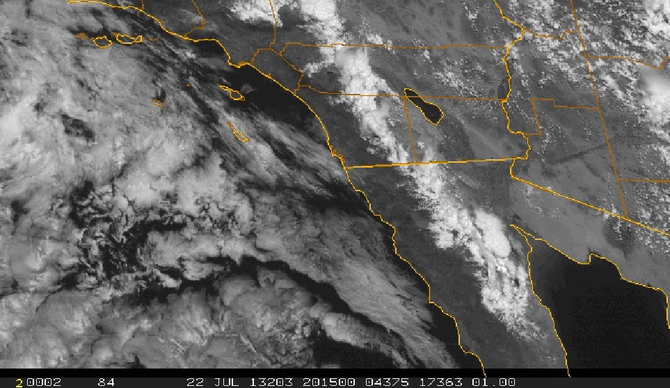 Facebook
Facebook
 X
X
 Instagram
Instagram
 TikTok
TikTok
 Youtube
Youtube

On July 22, the National Weather Serve activated San Diego County’s Emergency Alert System. Monsoonal moisture was causing large thunderstorms, running from Barstow south into Baja. The storm in San Diego was going to be stalled over the mountain areas of Pine Valley, east to Mt. Laguna, for up to two hours. A flash-flood warning was issued to residents in the mountains, which might face a threat of mudslides due to the recently burned areas around Mt. Laguna.
At 1:23 p.m., those watching cable TV had the audio portion interrupted by the Emergency Alert System for about 20 seconds. Viewers were advised in a top-of-the-screen crawl.
Additionally, KOGO AM 600 news reporter Jim Charvet announced the warning. Why KOGO? KOGO has been the government’s designated emergency station for decades. Other than broadcast towers based in Baja, KOGO has the strongest radio signal and can be received almost anywhere in San Diego County.
An employee of Major’s Coffee Shop in Pine Valley said there wasn’t any rain, but probably up in Laguna. A worker in the Mt Laguna Lodge & Store said there was only a drizzle, but the day before, when the weather service issued an alert, they got three inches in two hours. They take the Emergency Alert System warnings seriously.
Formerly known as the Emergency Broadcast System, it was established during the Cold War so the president of the United States could notify citizens of a national emergency or disaster, such as incoming nuclear missiles from Russia. Some older cars from the 1950s and ’60s, with their original AM radios, may have a little triangle, the symbol of the EBS system, on the dial, right at the 600 frequency.
Years after the threat of incoming nuclear missiles was reduced, the EBS system was disbanded in 1996. Local agencies now operate the system for floods, fires, earthquakes, or other emergencies.
As a young DJ and reporter at KAVO FM-107 in Fallbrook in the late 1970s, I can remember the FCC’s procedures for EBS activation. If it were a true emergency, United Press International would send a line of repeated X’s to their teletype machines in newsrooms across America, followed by the ringing of a bell in the machine — ten times (most big news stories got only a four-bell alert).
The reporter or DJ on the air was supposed to then open a sealed envelope — kept only in the broadcast booth — which contained secret codes. The codes represented the on-air person’s ID, distinguishing them from a Russian agent who may have taken over the station to cause a misinformation panic among the population. The envelopes arrived weekly, and federal law required that they remain sealed and destroyed if not needed.


On July 22, the National Weather Serve activated San Diego County’s Emergency Alert System. Monsoonal moisture was causing large thunderstorms, running from Barstow south into Baja. The storm in San Diego was going to be stalled over the mountain areas of Pine Valley, east to Mt. Laguna, for up to two hours. A flash-flood warning was issued to residents in the mountains, which might face a threat of mudslides due to the recently burned areas around Mt. Laguna.
At 1:23 p.m., those watching cable TV had the audio portion interrupted by the Emergency Alert System for about 20 seconds. Viewers were advised in a top-of-the-screen crawl.
Additionally, KOGO AM 600 news reporter Jim Charvet announced the warning. Why KOGO? KOGO has been the government’s designated emergency station for decades. Other than broadcast towers based in Baja, KOGO has the strongest radio signal and can be received almost anywhere in San Diego County.
An employee of Major’s Coffee Shop in Pine Valley said there wasn’t any rain, but probably up in Laguna. A worker in the Mt Laguna Lodge & Store said there was only a drizzle, but the day before, when the weather service issued an alert, they got three inches in two hours. They take the Emergency Alert System warnings seriously.
Formerly known as the Emergency Broadcast System, it was established during the Cold War so the president of the United States could notify citizens of a national emergency or disaster, such as incoming nuclear missiles from Russia. Some older cars from the 1950s and ’60s, with their original AM radios, may have a little triangle, the symbol of the EBS system, on the dial, right at the 600 frequency.
Years after the threat of incoming nuclear missiles was reduced, the EBS system was disbanded in 1996. Local agencies now operate the system for floods, fires, earthquakes, or other emergencies.
As a young DJ and reporter at KAVO FM-107 in Fallbrook in the late 1970s, I can remember the FCC’s procedures for EBS activation. If it were a true emergency, United Press International would send a line of repeated X’s to their teletype machines in newsrooms across America, followed by the ringing of a bell in the machine — ten times (most big news stories got only a four-bell alert).
The reporter or DJ on the air was supposed to then open a sealed envelope — kept only in the broadcast booth — which contained secret codes. The codes represented the on-air person’s ID, distinguishing them from a Russian agent who may have taken over the station to cause a misinformation panic among the population. The envelopes arrived weekly, and federal law required that they remain sealed and destroyed if not needed.
Comments